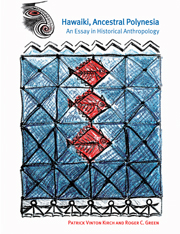Book contents
- Frontmatter
- Contents
- List of figures
- List of tables
- Preface
- List of language abbreviations
- Prologue: on historical anthropology
- Part I The phylogenetic model: theory and method
- Part II Rediscovering Hawaiki
- Introductory remarks
- 4 The Ancestral Polynesian world
- 5 Subsistence
- 6 Food preparation and cuisine
- 7 Material culture
- 8 Social and political organization
- 9 Gods, ancestors, seasons and rituals
- Epilogue: on history, phylogeny, and evolution
- Notes
- Glossary of terms
- References
- Subject Index
- Index of Proto Polynesian Reconstructions
Introductory remarks
Published online by Cambridge University Press: 06 January 2010
- Frontmatter
- Contents
- List of figures
- List of tables
- Preface
- List of language abbreviations
- Prologue: on historical anthropology
- Part I The phylogenetic model: theory and method
- Part II Rediscovering Hawaiki
- Introductory remarks
- 4 The Ancestral Polynesian world
- 5 Subsistence
- 6 Food preparation and cuisine
- 7 Material culture
- 8 Social and political organization
- 9 Gods, ancestors, seasons and rituals
- Epilogue: on history, phylogeny, and evolution
- Notes
- Glossary of terms
- References
- Subject Index
- Index of Proto Polynesian Reconstructions
Summary
We have chosen the title for Part II of our book – Rediscovering Hawaiki – quite consciously. We might have called it “reconstructing” Hawaiki, for one aim of the triangulation method within a phylogenetic model is to determine as fully as possible the ancestral culture which stands at the root of any “segment of cultural history.” But every label carries its own intellectual baggage, and the baggage of “reconstruction” includes an ubiquitous usage during the heyday of the New Archaeology, thus tending to be associated with an uncritical form of positivism. We recognize that history (or prehistory) is – to a certain degree – “constructed” by its practitioners, although we would strongly assert that what makes anthropological history a science and not an art is that its constructions of the past are self-consciously and continually constrained by the evidence. What is more, a central goal of triangulation is to assure that this array of evidence is as broad as possible, that it is not confined to any single line of inquiry, but draws upon the full spectrum of anthropological insight.
Thus we prefer rediscovering Hawaiki, a simple phrase that, in our view, more aptly conveys the essence of our enterprise. Hawaiki was, after all, in the indigenous Polynesian conception of their history the original homeland, a place – an island or islands – that their own ancestors had first discovered and populated (see below).
- Type
- Chapter
- Information
- Hawaiki, Ancestral PolynesiaAn Essay in Historical Anthropology, pp. 95 - 98Publisher: Cambridge University PressPrint publication year: 2001



